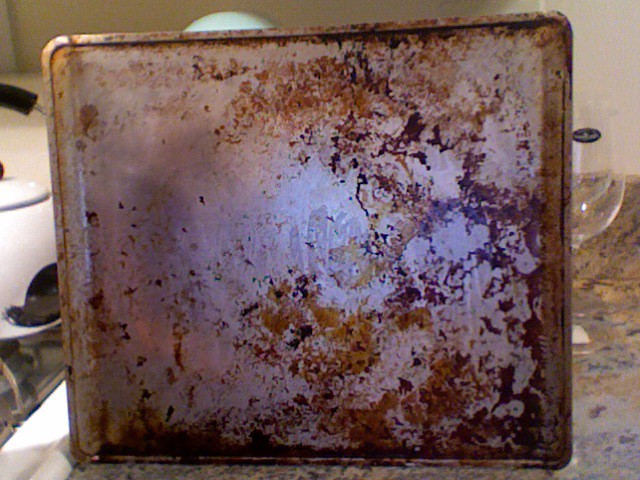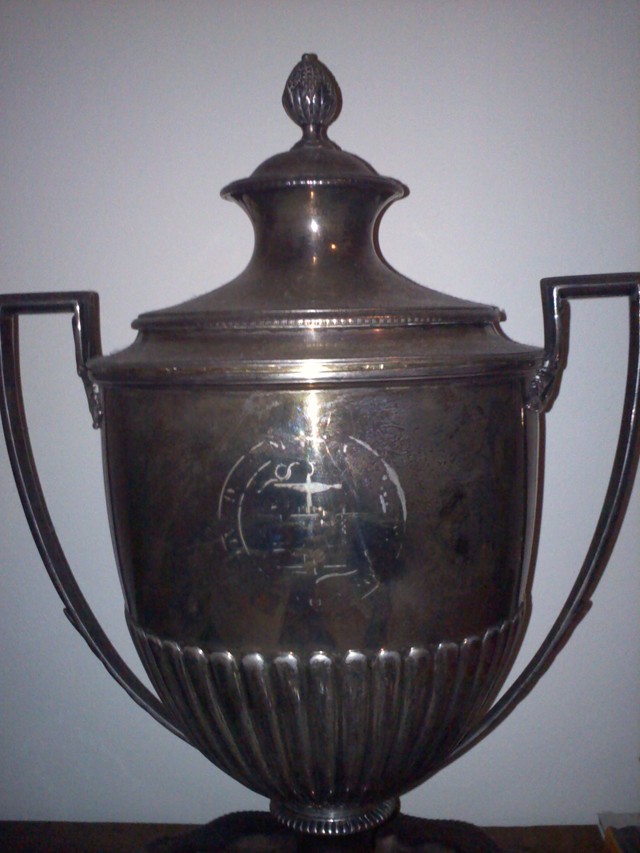Ask a Clean Person: Silver, Baking Sheets, and … Wine Vomit

There’s a baking sheet I’ve used for YEARS that looks absolutely disgusting, and I’d like it clean and shiny. It’s about seven years old. When I first bought it I was exceedingly broke and rarely could afford tinfoil. And I reheated pizza a lot. However, I have also scrubbed it many a time over the years. I have tried soaking, hot water, Brillo pads, and, most recently, Bar Keepers Friend. I am a strong woman, and I can’t get what’s still on there off. I come from a family that throws things out when they get dirty, so if you have mystical cleaning secrets, please share them. If cleaning this is impossible, I totally understand your passing on it, but this more than anything else is what I want to get clean.
Well shoot, if you’ve already tried Bar Keepers Friend I’m not sure what kind of help I’m going to be, because clearly you’ve got some mad cleaning chops, lady!
At the risk of alienating my audience on my first go as a cleaning columnist (my broom and I just performed a suggestive dance, such is the joy of this self-description!), I’ll say that I don’t actually find Bar Keepers Friend to be the life-changing product everyone else thinks it is. For my money, when it comes to mild abrasives Comet and Soft Scrub are where it’s at. So I’ll suggest for you and your very well loved baking sheet that you try a Comet and steel wool combo — head to your hardware store for a heavy duty steel wool if you can — with a healthy dollop of elbow grease. See if that does the trick. If not, there’s always tinfoil, which you can presumably now afford!
An aside on baking sheets: A wise chef friend once told me not to bother with expensive or name-brand cookie sheets because by their very nature they don’t take abuse well and need to be replaced every other year or so, regardless of quality. Expensive, name-brand cookware is one of my few materialistic vices, but when it comes to baking sheets I’m strictly low-end, with no shame.

I inherited this beautiful silver trophy vessel thing that’s gotten all dark and dingy. I think the answer to this is just “silver polish,” but how do I do that???
Lord have mercy, come to Mama! I have a crazy sickness that causes me to love polishing silver. Crazy, totally.
So yes, the answer is “silver polish,” but also the whole idea of polishing silver can be daunting if you don’t have someone to show or tell you how. Also, we’re talking about silver, which is faaaancy, so it’s completely OK to worry about getting things right.
There are nuances to polishing silver that depend on two main things:
1. The size of the object in need of shining up
2. The amount of detail involved in whatever it is you’re trying to polish
Bearing those variables in mind, I’ll ask that folks send me specific questions about polishing silver (with photos!) so that I can properly address the various scenarios one comes across when it comes to silver. (Does that make me sound desperate? Should I just let you come to me, without asking? OMG, I don’t even think I know how to do that? I’m going to go Ask a Dude how to play hard to get.)
Since the tarnished object in question here is HUGE, you can treat it with either a liquid or cream polish. I prefer a cream polish, and recommend Twinkle because it’s good and also because it’s called Twinkle, which is fun to say. When you’re ready to get to work, get yourself a rag of some sort — a scrap of old towel or t-shirt will work well here, truly something you don’t care about because the tarnish will stain — and the Twinkle. Dampen the rag, and rub it into the cream polish. You don’t need a ton, but you also want a good enough amount to work with. The good news is that you can’t really hurt things by using too much or too little, so you can find your own way in terms of the amount of polish to use as you go along.
Apply the polish by rubbing your polish-y rag in a circular motion across a small area of your silver. Continue along in this fashion until your little paw starts feeling crampy, and then rinse the polished area under warm water to admire your work! Oooooh shiny! I know, it’s amazing right?
Using that bit of progress to buoy your spirits, keep moving along until you’ve covered the entire surface. Once you’ve done that, rinse with warm water and buff with a dry, clean rag. (Again, here you’ll want to use a rag because the black from tarnish stains.) You can go back and touch up any spots that may be left.
The most important thing you need to know is to NEVER use any kind of abrasive tool on silver, because it scratches very, very, very easily. The back of a scrungy sponge, nope. A scrubber brush, nope. If you need a tool to get into crevices, the harshest thing you should ever use is a soft bristle toothbrush. If you learn nothing else from me, let that be it.
Hypothetical question: What does one use to remove red wine-vomit stains from a bathroom wall? A friend wants to know.
Oh dear, your poor friend! This is actually a pretty easy one: Wipe the whole mess down with a damp sponge with a touch of dishsoap, then Magic Erase it. And take an Advil? I mean, tell your friend to take an Advil?
Next week: Stains!
Jolie Kerr is not paid to endorse any of the products mentioned in this column but she sure would be very happily to accept any free samples the manufacturers care to send her way! Is anything you own dirty?